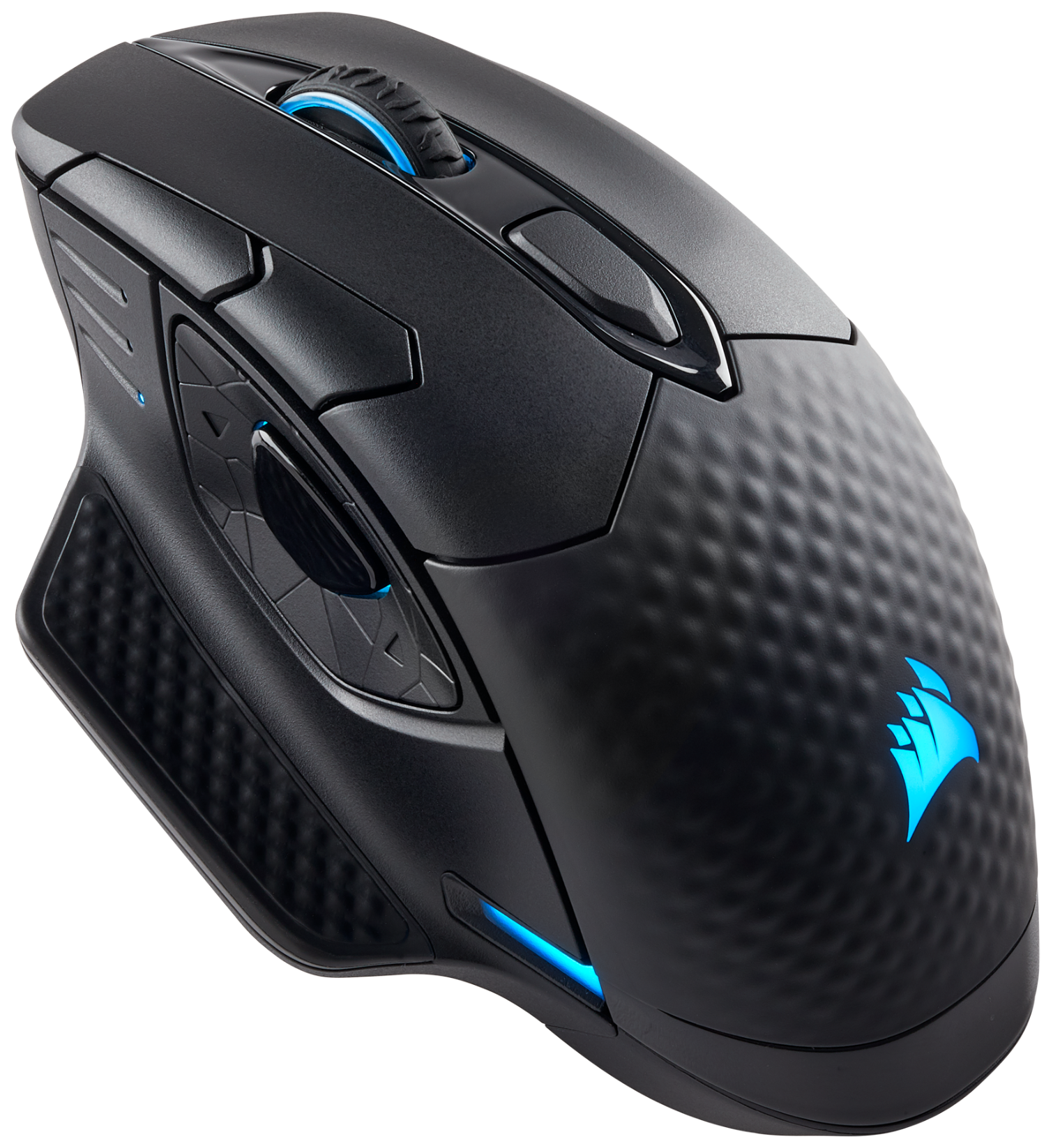Corsair Announces Wirelessly Charging Mouse And Pad








LAS VEGAS, NV -- At CES 2018, Corsair announced its first wirelessly charged mouse, the Dark Core RGB SE, and wireless charging mouse pad, the MM1000 Qi.
We first heard of Corsair’s wireless charging efforts at Computex 2017, when it was still a work in progress. Starting with the mouse, the Dark Core RGB SE is an all-new design from Corsair. It’s a right-handed design with an interchangeable, magnetically attached grip plate on its pinky side. Its real selling point is of course its built-in Qi charging module, which wirelessly recharges the mouse’s 24 hours of battery life. The mouse uses low-latency 2.4GHz Bluetooth and boasts a 16,000-DPI optical unit for a sensor. Its nine buttons and three-zone RGB lighting are programmed through Corsair’s unified driver, CUE, but the mouse has its own memory to store the settings.
What’s a wirelessly charged mouse without a wireless charging mousepad? The MM1000 Qi is Corsair’s new Qi-equipped mouse pad. Marked in at the top-right corner of this 350 x 260 mm hard mat is a spot where you can park your Dark Core SE for charging. With Qi, you don’t get the ability to charge while the mouse is moving, but you do get the benefit of being able to charge any Qi-compatible device, such as a smartphone. The MM1000 Qi even comes with a Qi charging dongle, complete with adapters, in case your smartphone doesn’t have it built-in. If you have more devices to charge, or just for convenience’s sake, the pad also has a USB 3.0 pass-through.
Rather confusingly, there is a non-SE version of the Dark Core RGB that doesn’t have wireless charging but is still wireless. Both mice can also run in wired mode with an included cable. The two versions of the Dark Core RGB and the MM1000 Qi will be available starting this month at $80 (Dark Core RGB), $90 (Dark Core RGB SE), and $80 (MM1000 Qi).
| Product | Dark Core RGB | Dark Core RGB SE |
|---|---|---|
| Sensor | PMW3367 (Optical) | PMW3367 (Optical) |
| Resolution | Up to 16,000 DPI | Up to 16,000 DPI |
| Ambidextrous | No (right-handed only) | No (right-handed only) |
| Switches | Omron (main mouse buttons only) | Omron (main mouse buttons only) |
| Polling Rate | 1,000Hz | 1,000Hz |
| Lighting | 3-zone RGB 16.8M colors | 3-zone RGB 16.8M colors |
| Buttons | 9 | 9 |
| Software | Corsair CUE | Corsair CUE |
| Cable | WirelessUSB | WirelessUSB |
| Dimensions (H x W x D) | 126.8 x 89.2 x 43.2mm | 126.8 x 89.2 x 43.2mm |
| Weight | 128g | 128g |
| Price | $80 | $90 |
Get Tom's Hardware's best news and in-depth reviews, straight to your inbox.
-
WyomingKnott This is purely a personal preference; different users will feel differently.Reply
I can't think of anything as useless to me as adding yet another inefficiency in the fuel-to-electricity-to-charging pipeline to spare me the trouble of remembering to plug in a charger. Cannot see myself using such a device until power is cheap and clean. That said, having the charger in the pad where the mouse always is is a pretty good idea.
OTOH, I used to think that I'd never read books on a device. Then the OLED screen came along and most of my reading is done on my tablet. Which is plugged into a charger at the moment. -
DRosencraft @WyomingKnott, the idea is that when you purchase and setup this system, you plug in the mouse pad one time, and there after you never have to worry about plugging in, charging, replacing batteries, or the like, with the mouse ever again, so long as you remember to put it on the mouse pad. Most folks keep their mouse in roughly the same spot on the table near their monitor, regardless of it being wireless or not.Reply
My question is whether the charger/mouse pad connects through AC outlet or USB. I'm assuming USB, so it can simply connect out the back of the PC (they do mention it has a USB pass-through). I would also expect the pad would provide the communication link between the PC and mouse, so that you don't need a separate unifying receiver. I've actually been talking to my brother about this for a few years now - why PC mice, which naturally pair with a pad that should be able to charge/power a relatively low-powered device, hadn't already been a thing. It's good to see wireless power tech pushing forward a little, but real penetration will come when this is an option at lower price points. It doesn't mention the cost of the charging mat, but the Razer version of this setup is apparently $250 - though it has RGBs in the mat too to help drive up its cost. If they can get the combined cost closer to $100 (which I believe is at least a couple years away) that is when wide-scale adoption will likely come about. For now, its something to think about for premium PC enthusiasts.